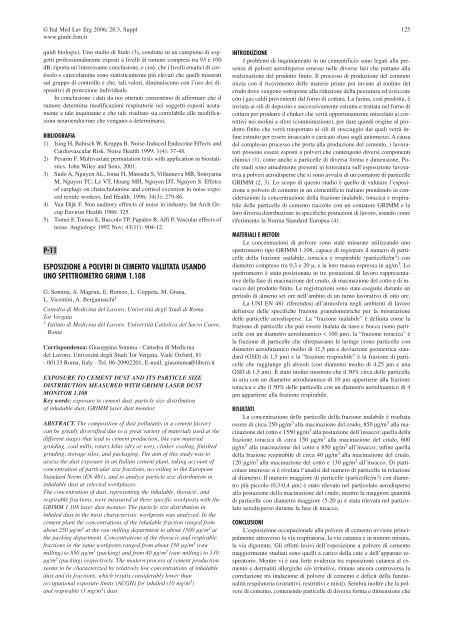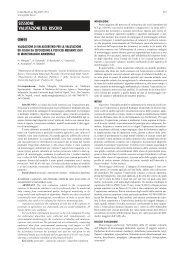Indice - Giornale Italiano di Medicina del Lavoro ed Ergonomia ...
Indice - Giornale Italiano di Medicina del Lavoro ed Ergonomia ...
Indice - Giornale Italiano di Medicina del Lavoro ed Ergonomia ...
You also want an ePaper? Increase the reach of your titles
YUMPU automatically turns print PDFs into web optimized ePapers that Google loves.
G Ital M<strong>ed</strong> Lav Erg 2006; 28:3, Suppl 125<br />
www.gimle.fsm.it<br />
qui<strong>di</strong> biologici. Uno stu<strong>di</strong>o <strong>di</strong> Sudo (3), condotta su un campione <strong>di</strong> soggetti<br />
professionalmente esposti a livelli <strong>di</strong> rumore compresi tra 93 e 100<br />
dB, riporta un’interessante conclusione, e cioè, che i livelli ematici <strong>di</strong> cortisolo<br />
e catecolamine sono statisticamente più elevati che quelli misurati<br />
sul gruppo <strong>di</strong> controllo e che, tali valori, <strong>di</strong>minuiscono con l’uso dei <strong>di</strong>spositivi<br />
<strong>di</strong> protezione in<strong>di</strong>viduale.<br />
In conclusione i dati da noi ottenuti consentono <strong>di</strong> affermare che il<br />
rumore determina mo<strong>di</strong>ficazioni respiratorie nei soggetti esposti acutamente<br />
a tale inquinante e che tale risultato sia correlabile alle mo<strong>di</strong>ficazioni<br />
neuroendocrine che vengano a determinarsi.<br />
BIBLIOGRAFIA<br />
1) Ising H, Babisch W, Kruppa B. Noise-Induc<strong>ed</strong> Endocrine Effects and<br />
Car<strong>di</strong>ovascular Risk. Noise Health 1999; 1(4): 37-48.<br />
2) Pesarin F. Multivariate permutation tests with application in biostatistics.<br />
John Wiley and Sons, 2001.<br />
3) Sudo A, Nguyen AL, Jonai H, Matsuda S, Villanueva MB, Sotoyama<br />
M, Nguyen TC, Le VT, Hoang MH, Nguyen DT, Nguyen S. Effetcs<br />
of earplugs on chatecholamine and cortisol excretion in noise expos<strong>ed</strong><br />
textile workers. Ind Health. 1996; 34(3): 279-86.<br />
4) Van Dijk F. Non au<strong>di</strong>tory effetcts of noise in industry. Int Arch Occup<br />
Environ Health 1986; 325.<br />
5) Tomei F, Tomao E, Baccolo TP, Papaleo B, Alfi P. Vascular effects of<br />
noise. Angiology 1992 Nov; 43(11): 904-12.<br />
P-11<br />
ESPOSIZIONE A POLVERI DI CEMENTO VALUTATA USANDO<br />
UNO SPETTROMETRO GRIMM 1.108<br />
G. Somma, A. Magrini, E. Romeo, L. Coppeta, M. Grana,<br />
L. Vicentini, A. Bergamaschi1 Catt<strong>ed</strong>ra <strong>di</strong> Me<strong>di</strong>cina <strong>del</strong> <strong>Lavoro</strong>, Università degli Stu<strong>di</strong> <strong>di</strong> Roma<br />
Tor Vergata<br />
1 Istituto <strong>di</strong> Me<strong>di</strong>cina <strong>del</strong> <strong>Lavoro</strong>. Università Cattolica <strong>del</strong> Sacro Cuore,<br />
Roma<br />
Corrispondenza: Giuseppina Somma - Catt<strong>ed</strong>ra <strong>di</strong> Me<strong>di</strong>cina<br />
<strong>del</strong> <strong>Lavoro</strong>, Università degli Stu<strong>di</strong> Tor Vergata, Viale Oxford, 81<br />
- 00133 Roma, Italy - Tel. 06-20902201, E-mail: giusomma@libero.it<br />
EXPOSURE TO CEMENT DUST AND ITS PARTICLE SIZE<br />
DISTRIBUTION MEASURED WITH GRIMM LASER DUST<br />
MONITOR 1.108<br />
Key words: exposure to cement dust, particle size <strong>di</strong>stribution<br />
of inhalable dust, GRIMM laser dust monitor.<br />
ABSTRACT. The composition of dust pollutants in a cement factory<br />
can be greatly <strong>di</strong>versifi<strong>ed</strong> due to a great variety of materials us<strong>ed</strong> at the<br />
<strong>di</strong>fferent stages that lead to cement production, like raw material<br />
grin<strong>di</strong>ng, coal mills, rotary kilns (dry or wet), clinker cooling, finish<strong>ed</strong><br />
grin<strong>di</strong>ng, storage silos, and packaging. The aim of this study was to<br />
assess the dust exposure in an Italian cement plant, taking account of<br />
concentration of particular size fractions, accor<strong>di</strong>ng to the European<br />
Standard Norm (EN 481), and to analyze particle size <strong>di</strong>stribution in<br />
inhalable dust at select<strong>ed</strong> workplaces.<br />
The concentration of dust, representing the inhalable, thoracic, and<br />
respirable fractions, were measur<strong>ed</strong> at three specific workposts with the<br />
GRIMM 1.108 laser dust monitor. The particle size <strong>di</strong>stribution in<br />
inhal<strong>ed</strong> dust in the most characteristic workposts was analyz<strong>ed</strong>. In the<br />
cement plant the concentrations of the inhalable fraction rang<strong>ed</strong> from<br />
about 250 µg/m 3 at the raw milling department to about 1500 µg/m 3 at<br />
the packing department. Concentrations of the thoracic and respirable<br />
fractions in the same workposts rang<strong>ed</strong> from about 150 µg/m 3 (raw<br />
milling) to 850 µg/m 3 (packing) and from 40 µg/m 3 (raw milling) to 130<br />
µg/m 3 (packing) respectively. The modern process of cement production<br />
seems to be characteriz<strong>ed</strong> by relatively low concentrations of inhalable<br />
dust and its fractions, which results considerably lower than<br />
occupational exposure limits (ACGH) for inhal<strong>ed</strong> (10 mg/m 3 )<br />
and respirable (3 mg/m 3 ) dust.<br />
INTRODUZIONE<br />
I problemi <strong>di</strong> inquinamento in un cementificio sono legati alla presenza<br />
<strong>di</strong> polveri aero<strong>di</strong>sperse emesse nelle <strong>di</strong>verse fasi che portano alla<br />
realizzazione <strong>del</strong> prodotto finito. Il processo <strong>di</strong> produzione <strong>del</strong> cemento<br />
inizia con il ricevimento <strong>del</strong>le materie prime poi inviate al molino <strong>del</strong><br />
crudo dove vengono sottoposte alla riduzione <strong>del</strong>la pezzatura <strong>ed</strong> essiccate<br />
con i gas cal<strong>di</strong> provenienti dal forno <strong>di</strong> cottura. La farina, così prodotta, è<br />
inviata ai sili <strong>di</strong> deposito e successivamente estratta e trattata nel forno <strong>di</strong><br />
cottura per produrre il clinker che verrà opportunamente miscelato ai correttivi<br />
nei molini a sfere (comminuzione), per dare quin<strong>di</strong> origine al prodotto<br />
finito che verrà trasportato ai sili <strong>di</strong> stoccaggio dai quali verrà infine<br />
estratto per essere insaccato o caricato sfuso sugli automezzi. A causa<br />
<strong>del</strong> complesso processo che porta alla produzione <strong>del</strong> cemento, i lavoratori<br />
possono essere esposti a polveri che contengono <strong>di</strong>versi componenti<br />
chimici (1), come anche a particelle <strong>di</strong> <strong>di</strong>versa forma e <strong>di</strong>mensione. Pochi<br />
stu<strong>di</strong> sono attualmente presenti in letteratura sull’esposizione lavorativa<br />
a polveri aero<strong>di</strong>sperse che si sono avvalsi <strong>di</strong> un contatore <strong>di</strong> particelle<br />
GRIMM (2, 3). Lo scopo <strong>di</strong> questo stu<strong>di</strong>o è quello <strong>di</strong> valutare l’esposizione<br />
a polvere <strong>di</strong> cemento in un cementificio italiano prendendo in considerazione<br />
la concentrazione <strong>del</strong>la frazione inalabile, toracica e respirabile<br />
<strong>del</strong>le particelle <strong>di</strong> cemento raccolte con un contatore GRIMM e la<br />
loro <strong>di</strong>versa <strong>di</strong>stribuzione in specifiche postazioni <strong>di</strong> lavoro, usando come<br />
riferimento la Norma Standard Europea (4).<br />
MATERIALI E METODI<br />
Le concentrazioni <strong>di</strong> polvere sono state misurate utilizzando uno<br />
spettrometro tipo GRIMM 1.108, capace <strong>di</strong> registrare il numero <strong>di</strong> particelle<br />
<strong>del</strong>la frazione inalabile, toracica e respirabile (particelle/m 3 ) con<br />
<strong>di</strong>ametro compreso tra 0,3 e 20 µ, e la loro massa espressa in µg/m 3 . Lo<br />
spettrometro è stato posizionato in tre postazioni <strong>di</strong> lavoro rappresentative<br />
<strong>del</strong>la fase <strong>di</strong> macinazione <strong>del</strong> crudo, <strong>di</strong> macinazione <strong>del</strong> cotto e <strong>di</strong> insacco<br />
<strong>del</strong> prodotto finito. Le registrazioni sono state eseguite durante un<br />
periodo <strong>di</strong> almeno sei ore nell’ambito <strong>di</strong> un turno lavorativo <strong>di</strong> otto ore.<br />
La UNI EN 481 riferendosi all’atmosfera negli ambienti <strong>di</strong> lavoro<br />
definisce <strong>del</strong>le specifiche frazioni granulometriche per la misurazione<br />
<strong>del</strong>le particelle aero<strong>di</strong>sperse. La “frazione inalabile” è definita come la<br />
frazione <strong>di</strong> particelle che può essere inalata da naso e bocca (sono particelle<br />
con un <strong>di</strong>ametro aero<strong>di</strong>namico < 100 µm), la “frazione toracica” è<br />
la frazione <strong>di</strong> particelle che oltrepassano la laringe (sono particelle con<br />
<strong>di</strong>ametro aero<strong>di</strong>namico me<strong>di</strong>o <strong>di</strong> 11,5 µm e deviazione geometrica standard<br />
(GSD) <strong>di</strong> 1,5 µm) e la “frazione respirabile” è la frazione <strong>di</strong> particelle<br />
che raggiunge gli alveoli (con <strong>di</strong>ametro me<strong>di</strong>o <strong>di</strong> 4,25 µm e una<br />
GSD <strong>di</strong> 1,5 µm). È stato inoltre mostrato che il 50% circa <strong>del</strong>le particelle<br />
in aria con un <strong>di</strong>ametro aero<strong>di</strong>namico <strong>di</strong> 10 µm appartiene alla frazione<br />
toracica e che il 50% <strong>del</strong>le particelle con un <strong>di</strong>ametro aero<strong>di</strong>namico <strong>di</strong> 4<br />
µm appartiene alla frazione respirabile.<br />
RISULTATI<br />
La concentrazione <strong>del</strong>le particelle <strong>del</strong>la frazione inalabile è risultata<br />
essere <strong>di</strong> circa 250 µg/m 3 alla macinazione <strong>del</strong> crudo, 850 µg/m 3 alla macinazione<br />
<strong>del</strong> cotto e 1550 µg/m 3 alla postazione <strong>del</strong>l’insacco; quella <strong>del</strong>la<br />
frazione toracica <strong>di</strong> circa 150 µg/m 3 alla macinazione <strong>del</strong> crudo, 600<br />
µg/m 3 alla macinazione <strong>del</strong> cotto e 850 µg/m 3 all’insacco; infine quella<br />
<strong>del</strong>la frazione respirabile <strong>di</strong> circa 40 µg/m 3 alla macinazione <strong>del</strong> crudo,<br />
120 µg/m 3 alla macinazione <strong>del</strong> cotto e 130 µg/m 3 all’insacco. Di particolare<br />
interesse si è rivelata l’analisi <strong>del</strong> numero <strong>di</strong> particelle in relazione<br />
al <strong>di</strong>ametro. Il numero maggiore <strong>di</strong> particelle (particelle/m 3 ) con <strong>di</strong>ametro<br />
più piccolo (0,3-0,4 µm) è stato rilevato nel particolato aero<strong>di</strong>sperso<br />
alla postazione <strong>del</strong>la macinazione <strong>del</strong> crudo, mentre la maggiore quantità<br />
<strong>di</strong> particelle con <strong>di</strong>ametro maggiore (5-20 µ) è stata rilevata nel particolato<br />
aero<strong>di</strong>sperso durante la fase <strong>di</strong> insacco.<br />
CONCLUSIONI<br />
L’esposizione occupazionale alla polvere <strong>di</strong> cemento avviene principalmente<br />
attraverso la via respiratoria, la via cutanea e in minore misura,<br />
la via <strong>di</strong>gerente. Gli effetti lesivi <strong>del</strong>l’esposizione a polvere <strong>di</strong> cemento<br />
maggiormente stu<strong>di</strong>ati sono quelli a carico <strong>del</strong>la cute e <strong>del</strong>l’apparato respiratorio.<br />
Mentre vi è una forte evidenza tra esposizione cutanea al cemento<br />
e dermatiti allergiche e/o irritative, rimane ancora controversa la<br />
correlazione tra inalazione <strong>di</strong> polvere <strong>di</strong> cemento e deficit <strong>del</strong>la funzionalità<br />
respiratoria (ostruttivi, restrittivi e misti). Sembra inoltre che la polvere<br />
<strong>di</strong> cemento, contenendo particelle <strong>di</strong> <strong>di</strong>versa forma e <strong>di</strong>mensione che
















